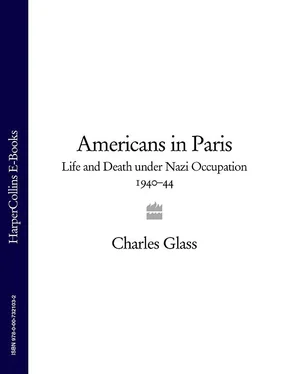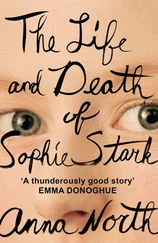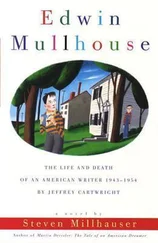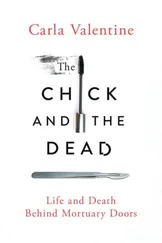The American community in Paris, the largest in continental Europe, had little to fear from the Germans. The United States stood aloof from the war between Germany and the Allies, and it enjoyed the respect of both sides. Although Ambassador Bullitt had advised American citizens without vital business to leave when France and Britain declared war on Germany in September 1939, about half had elected to stay. The drôle de guerre , which the Germans called the Sitzkrieg and the British and Americans the ‘phoney war’, dragged on for the next eight months. Only the occasional air raid drill or the sight of sandbags around the monuments disturbed their routine. In May 1940, the German advance through Holland and Belgium into France was so swift that the Americans who feared life under German occupation fled south from Paris. Three weeks before the city fell, as the French and British armies retreated, The New York Times ’ front page announced, ‘Most Americans Staying in Paris’: ‘The United States Embassy said that of the slightly more than 3,600 Americans in the Paris district on Dec. 31, about 2,500 are still here. They are mostly businessmen and members of their families and newspaper men, more of whom have been arriving recently.’
The journalists were not the only American arrivals. American Field Service ambulances, funded and directed by the indefatigable sister of New York financier J. P. Morgan, Miss Anne Morgan, ferried wounded British and French soldiers to hospitals from the front throughout the Battle of France. As soon as the Wehrmacht invaded neighbouring Belgium on 10 May, hundreds of young American men rushed to France. They swore to defend democracy, just as 17,000 Frenchmen had answered the Marquis de Lafayette’s call to fight for American independence. So many Americans attempted to join the French Army during the Battle of France that the French could not accommodate them all. Twenty-seven-year-old Tom McBride of Queens, New York, and twelve aviator colleagues attempted to reconstitute the old Lafayette Escadrille, the squadron of American pilots who fought for France in the Great War. When they reached Paris on 1 May 1940, they were welcomed by General Aldebert de Chambrun, a direct descendant of Lafayette, and the air minister. ‘They showed us all over Paris,’ McBride said, ‘then dropped us cold.’ He complained, ‘All the Air Minister would say was, “Wait. Wait. Wait.”’ The French Air Corps commissioned McBride a lieutenant, but he never got the chance to fly against the Luftwaffe. Undeterred, he went to Canada and joined the Royal Canadian Air Force.
American citizens who remained in Paris had little to fear. The embassy issued more than 1,000 red certificates, signed by Third Secretary Tyler Thompson, to indicate which houses and businesses belonged to American citizens and could not, under international law, be touched. The Americans’ institutions – the American Hospital in the fashionable western suburb of Neuilly, the American Library in the rue de Téhéran, the American Cathedral on the avenue George-V, the American Church on the Quai d’Orsay, the Rotary Club, the American Chamber of Commerce and many other clubs and charitable societies – were still functioning. The American Church bulletin had announced the previous Sunday, ‘The American Church will continue its activities and remain open throughout the days to come. The building will be open daily and the various groups will meet as usual.’ The Americans’ newspaper, the Paris Herald Tribune , went on publishing until 12 June, the last paper sold in Paris before the Germans arrived. The American Ambassador, despite White House and State Department entreaties, refused to leave. ‘No American ambassador in Paris has ever run away from anything,’ Bullitt cabled President Franklin Delano Roosevelt, ‘and that I think is the best tradition we have in the American diplomatic service.’ That tradition dated to Gouverneur Morris’s decision to stay during the French Revolution. Elihu B. Washburne continued it throughout the German occupation of 1870. In 1914, when Germany’s offensive put Paris within range of the Kaiser’s artillery, every ambassador except the American, Myron T. Herrick, fled. Bullitt would not to be the first to cut and run.
Born in Philadelphia in January 1891 to a WASP family of rich lawyers and railroad magnates who traced their American ancestors through Patrick Henry and Pocahontas, Bullitt spent much of his youth in Europe. His mother’s family, the Horowitzes, was originally German Jewish. The family spoke French at home, and he learned German in Munich. Graduating from Yale in 1912, Bullitt covered the world war in Russia, Germany, Austria and France as a correspondent for the Philadelphia Public Ledger . When America entered on the Allied side in 1917, the State Department hired him to conduct research for its intelligence section. President Woodrow Wilson took him to the Paris Peace Conference in 1918 as part of the American commission. Bullitt resigned, along with historian Samuel Eliot Morison and six other diplomats, to protest the terms of the Versailles Treaty. He pointed out to Wilson that the treaty, with its other flaws, left three million Germans under Czech rule and abandoned thirty-six million Chinese in Shantung to Japan. His resignation letter lamented, ‘But our government has consented now to deliver the suffering peoples of the world to new oppressions, subjection, and dismemberments – a new century of war.’ He predicted, ‘This isn’t a treaty of peace. I can see at least eleven wars in it.’ Political oblivion followed, but he had the funds to enjoy himself in a palace in Istanbul and luxurious apartments in Paris. His only novel, It’s Not Done , sold 150,000 copies in 1925 – prompting Ernest Hemingway, whose books were not selling as well, to mention him in a letter to F. Scott Fitzgerald in 1927 as ‘Bill Bullitt or Bull Billet, a big Jew from Yale and a fellow novel writer’. He married Louise Bryant, whose late husband, John Reed, had died in Russia after documenting its revolution in Ten Days that Shook the World . Bullitt and Louise had one child, Anne, and divorced in 1930. When his friend Franklin Delano Roosevelt became president in 1933, he appointed Bullitt America’s first ambassador to the Soviet Union. Bullitt’s initial enthusiasm for the Russian Revolution collapsed in the face of Stalinist repression.
In 1936, FDR assigned Bullitt to Paris, where the French admired his style. He employed an excellent chef, served only the finest wines, dressed immaculately and flirted in flawless French. Bullitt rented the Château de Vineuil-Saint-Firmin in thoroughbred country at Chantilly, where he entertained France’s senior politicians at weekends. Ernest Hemingway, who had left Paris in 1929 but visited during the Spanish Civil War from 1936 to 1939, came out occasionally to shoot clay pigeons. During the week, Bullitt lived with his daughter, Anne, in the embassy residence in avenue d’Iéna. He negotiated vigorously in Europe for American interests, while advocating the French cause in Washington. No foreign ambassador was closer to the French cabinet, many of whom confided personal and state secrets in him. After three years in France, during which the country received persecuted Jewish refugees from Germany and Austria, Bullitt hated Hitler as much as he did Stalin. In March 1940, the German Foreign Office released a ‘White Book’ of transcripts seized in Warsaw in which Bullitt told the Polish Ambassador to Washington, Count Jerzy Potocki, that ‘the French Army is the first line of defense for the United States’. The German press accused Bullitt and Ambassador to Britain Joseph Kennedy, despite Kennedy’s reputation for appeasement of Nazi Germany, of ‘using all their influence to aggravate the atmosphere of hostility in Europe’. The Nazis regarded Bullitt as the American diplomat most hostile to Germany, and they were probably right. No one fought harder to persuade America to send planes, tanks and other armaments to France. He had even arranged for French pilots secretly to test fly the latest American warplanes.
Читать дальше












